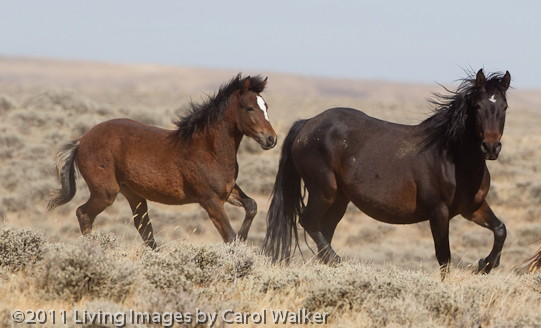
Wild Horses: Leading a BBC News Crew to Visit Wyomings Wild Horses
November 11, 2011Wild Horses: 40th Annivesary of 1971 Act Legal Forum at NYU on 11/16
November 14, 2011Wild Horses: The Good, The Bad and the ugly in Wyoming Roundups, Part 2
When I arrived for the second day of the Great Divide Basin Roundup, the “bad” became evident. They were loading up horses, the mares and foals to go to Rock Springs, the stallions to go to Utah, and I found out that all of the horses gathered at this trap site were to be removed from the area forever. This is because they were outside the Herd Management Area. This whole larger area used to be a Herd Area, where horses were found at the time of the 1971 Act, but just like in hundreds of areas across the west, the BLM has reduced the area wild horses can roam free upon.
When I asked how the helicopter pilot would know exactly where the boundary is, I was told that even if the horses were inside the HMA, they were close enough to the boundary that probably were going in and out of the herd area anyway. We were only allowed to see a small group of stallions left in the pen, waiting for the next truck load.
As they looked out toward the Wind River Mountains, the view that they would never see again, I felt a tremendous sense of frustration start to build. That is a familiar feeling when I am visiting a roundup.
We were placed about a half a mile from the trap, and about a mile from the path that the horses would take to the trap – just far enough that even with an extremely long lens, most of the time the horses would be colored dots. We waited for the wind to die down, but it never did that day, so I drove out, leading Ginger Kathrens and Lauryn Wachs out to see the horses of the Great Divide Basin before their lives changed forever. Here is a video from the Cloud Foundation about our experiences:
We saw many horses that day who had no idea about the helicopters that would soon be coming to change their lives forever. My favorite was a little band of four, a dark stallion and mare and their two year old filly and young colt. They were very curious about us and kept getting closer and closer to take a look. I hope they hide…..
Then we saw a large group of rowdy bachelors from the highway, and when we approached they ran back and forth giving us quite a show.
Then we saw many bands all coming down for water. It was a beautiful ending to an unexpectedly peaceful day with the horses of Divide Basin before they lost their freedom.
The next day I was back at the roundup. From far away it was hard to see what was going on, but at one point shortly after we were told that one reason for the BLM’s removing horses from this area was that is was a migration corridor for pronghorn antelope, we could see antelope streaming as they ran from the helicopter, in front of the horses.
Funny how the antelope don’t seem to be disturbed by the horses, but they certainly are by the helicopters! I was very concerned that they might run into the trap, but luckily they veered away at the last moment.
At the very end of the day I see a colorful band that included a mare and a foal evading the trap over and over again, still chased by the helicopter, but finally the black mare escapes and I no longer see the foal. Was he captured? When I ask no one seems to know – the wranglers had gone out to catch a foal earlier, and I hope that was him.
When I go out early the next morning, just before I get to the trap at dawn, I see a beautiful family run by the road – a red bay stallion, a palomino mare and her red bay colt.
I wonder if they had been visiting the stallions in the pens. It is nice to see one family still free here, And what is the very first thing that the helicopter does – capture family, and separate them from their homes and each other forever.
The helicopter brings in just a few more small bands before quitting for the day, and ending the removals of horses considered to be “outside the herd area.” None of these horses will be returned to their homes. The stallions are being shopped to a holding facility in Utah and the mares and foals are shipped to Rock Springs. On my way back to Rock Springs I decide to stop at the BLM Rock Springs short term holding facility.
There is an area that looks out over where the horses are held. Here, wild horses are tagged, freeze branded, given vaccinations, coggins test, and the stallions are gelded. There are the pens for mares and some foals, pens for weanlings, and pens for stallions, soon to be geldings.
There really is no more depressing sight than these once free beautiful and proud wild horses milling listlessly around these sterile pens. There are horses here from the earlier Red Desert roundup as well as from the Great Divide Basin Roundup. I see a grulla filly calling out, whinnying for her family – she moves up and down searching for her family, and no one answers her.
Then I see a foal lying down – at first I am concerned she might be dead, but when a mare approached her, she moves an starts to get up, finally moving to her mother. She might have been born here in this pen – this is the only world she knows.
And this is the worst of the roundups – these horses, dull, listless in captivity. No shelter, no family, no hope for the future for these horses.
This is what needs to change.

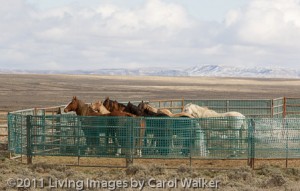
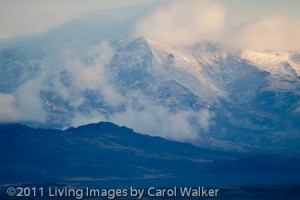
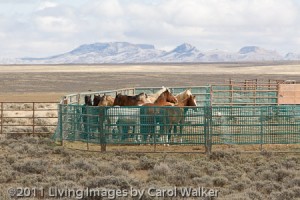
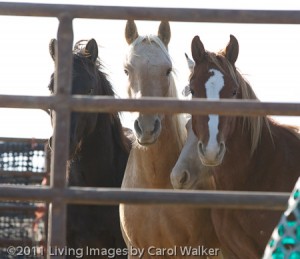
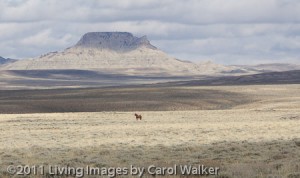
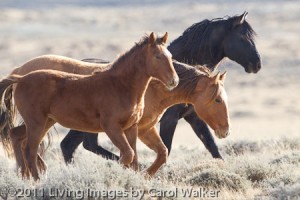
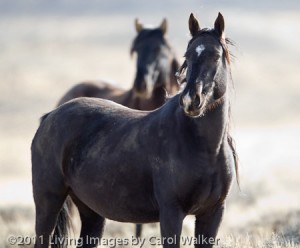
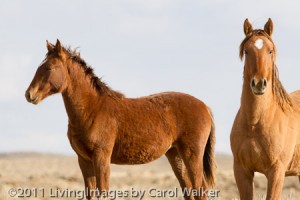
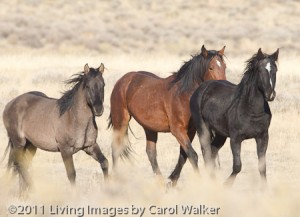
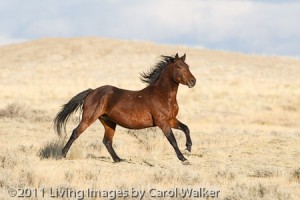
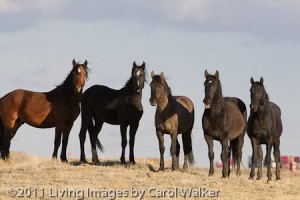
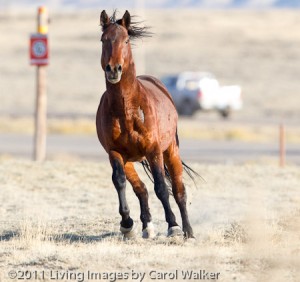
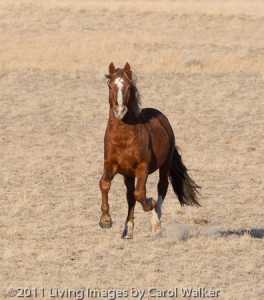
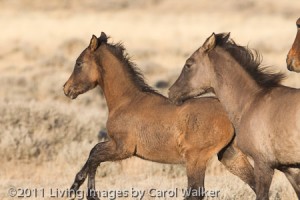
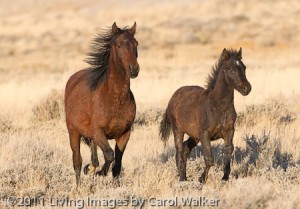
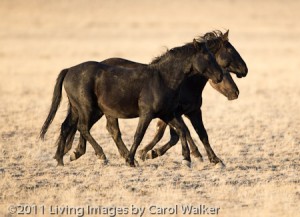
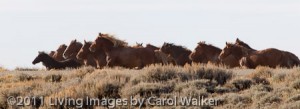
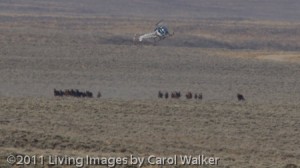
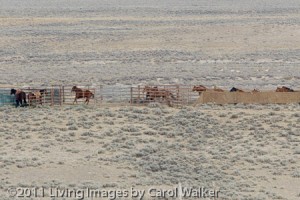
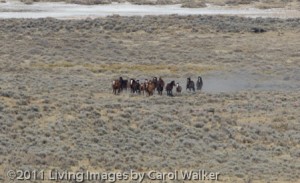

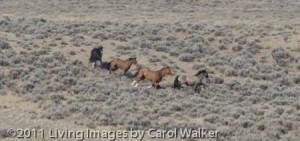
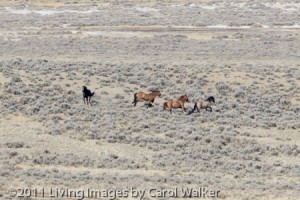
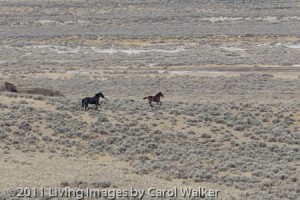
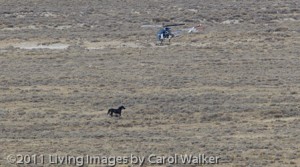
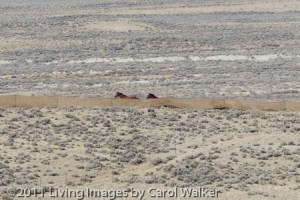
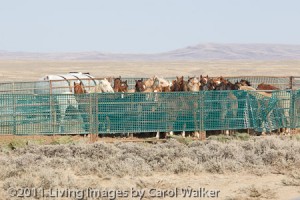
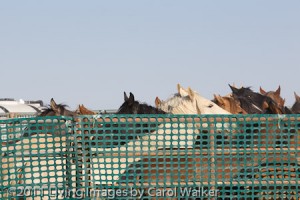
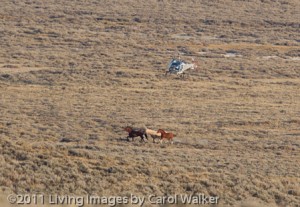
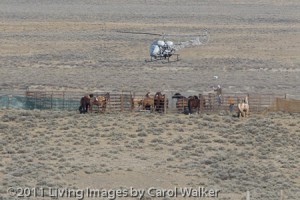
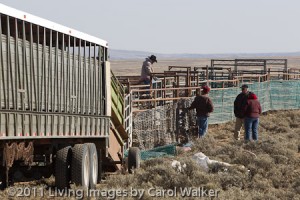
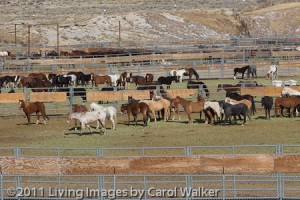
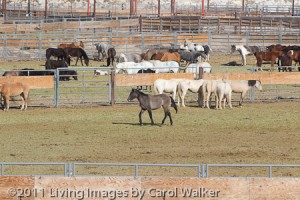
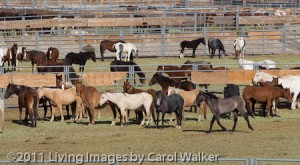
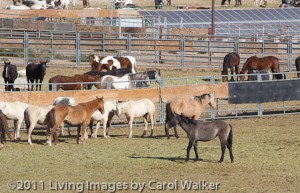
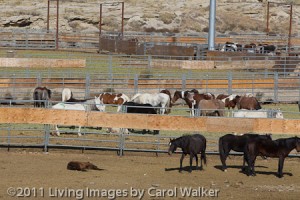
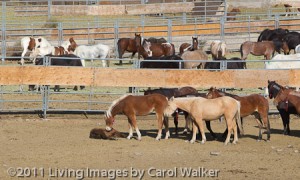
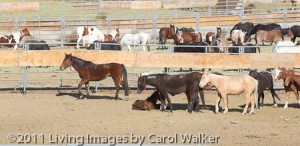
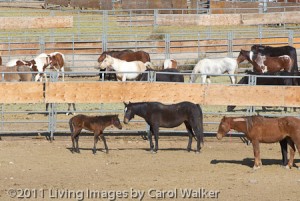
9 Comments
If we all work together, some how some way OUR word needs to get out,,,,,This is such cruel ways to keep Gods country safe,,and our beauty natural,,IT’s there home ,,Leave them alone!!!!!!!!!!!!!!!!!!!!!!!
thank -U so much Carol for keeping us updated on this,,,,,,
From what ive been told the people who are to protect the horses are the ones doing the round ups
I;m with you Debbie,the BLM’S of this country need to leave these magnificent beautiful wild horses and burro’s alone and stop wasting taxpayers money on the senceless roundups that do nothing but treat our wild horses and burro’s very cruel and inhumanely.LEAVE THE WILD HORSES AND BURR’S ALONE NOW!!!
I believe what the BLM intends to do is lease all of the millions of acres to the cattle industry. There is a lot of money to be made selling US beef to South Korea under the new trade agreements signed a few weeks ago. The South Korean’s said they would buy US beef if the cows were 30 months old. This is because of the ban some countries have had on beef from the US because of Mad Cow disease some years ago. Now that has been resolved the US is looking to export all the beef it can and it needs all the available grazing it can get for the ranchers.
If anyone believes that the Big Horn Sheep need the amount of land that can be seen in these photos I have a huge bridge I will be glad to sell you.
How heartbreaking to witness this callous and cruel round-up. I fully expect that most of these poor, poor horses will end up in Canadian or Mexican slaughter-houses, just so the the BLM and fat cattle-ranchers can line their pockets with more filthy, blood-money. When will this end? Unfortunaely, this will only end when vitually ALL the wild horses and burros are gone, gone forever. Gone to be replaced by the cattle, gone to satisfy the BLM and the ranchers’ greed for more dirty-games earned money, gone to feed the disgusting horse-meat eaters in Europe and Japan, gone, and in time, totally forgotten. The icons of early America – GONE!!! RIP
Just saddens me. Families separated, taken from their home…never to be free again. And like Irene said, will likely end up in a slaughterhouse. Horses are NOT food for humans…get a grip people. And you fat a$$ cattle ranchers…maybe people should quit buying your meat…maybe you’ll lose a few pounds…
Carol, thank you for taking the time to document and post what is happening to our wild horses. It’s so sad to see them in pens, and the filly calling for her family was particularly heartbreaking. The thing that infuriates me is everything behind these roundups is fueled by greed, cold-hearted people, and a total disregard for the wild horses. There is no need for this to happen, but the BLM keep spinning their stories. They have no more care for these animals than an insect they can crush beneath their boots.
So sad but thank you.